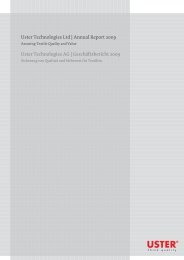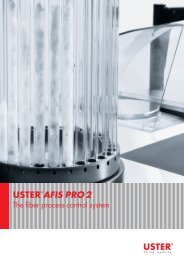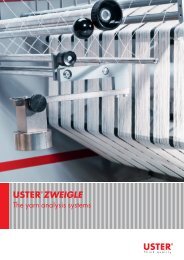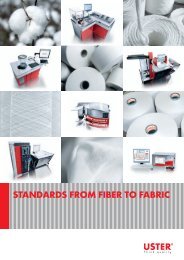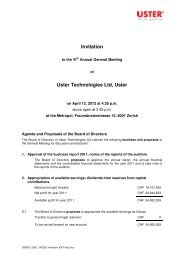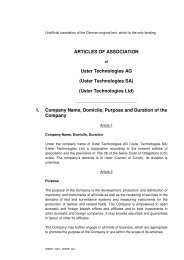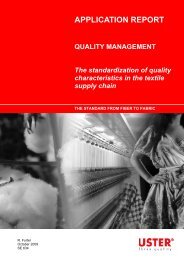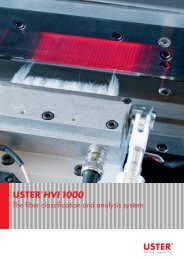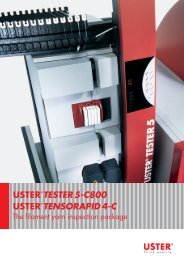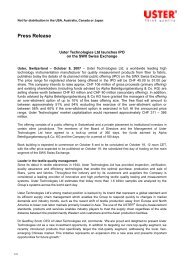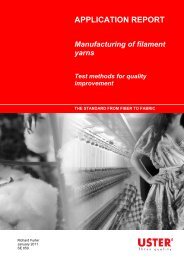Application Handbook_Uster_Statistics - Uster Technologies
Application Handbook_Uster_Statistics - Uster Technologies
Application Handbook_Uster_Statistics - Uster Technologies
- No tags were found...
Create successful ePaper yourself
Turn your PDF publications into a flip-book with our unique Google optimized e-Paper software.
Parameter Abbreviation Unit Instrument No of samples Test withinYarn classificationYarn classificationTable 3-2NSLTFDNSLTFDVEGPPOutliers1/100 km1/100 km1/100 km1/100 kmUSTER ® CLASSIMATQUANTUMUSTER ® CLASSIMAT 5Testing length: 100 km (ring spun)Testing length: 300 km (OE-rotor)Testing length: 200km (ring spun)Testing length: 200 km (OE-rotor)Testing of rovingsParameter Abbreviation Unit Instrument No of samples Test withinCount variations CV cb % USTER ® TESTER 5FA SensorMass variationsTable 3-3CV mCV m 1mCV m 3m%%%USTER ® TESTER 5CS Sensor10Length 10 m101010Testing speed:Duration of test:111150 m/min5 minTesting of sliversParameter Abbreviation Unit Instrument Reference lengthMass variationCV m%CV m 1m %CV m 3m %CV m 10m %USTER ®SLIVERGUARD100 m100 m100 m100 mTable 3-4Ambient Laboratory Conditions for Fiber and Yarn TestingSome textile fibers are highly hygroscopic and their properties change notably as a function of themoisture content. Typical hygroscopic fibers are cotton, wool, rayon, silk, flax, etc. Moisture content isparticularly critical in the case of dynamometric properties, i.e. yarn tenacity, elongation, and work-tobreak,but yarn evenness, imperfections, and defect levels are also affected. As a result, conditioningand testing must be carried out under constant standard atmospheric conditions. The standardtemperate atmosphere for textile testing according to ISO 139 involves a temperature of 20±2°C(68±4°F) and 65±4% relative humidity. The standard alternative atmospheres according to ISO 139shall have a temperature of 23±2°C (73.4±4°F) of and a relative humidity of of 50±4%). Thealternative atmosphere may be used only if the parties involved agree on its use. Prior to testing, thesamples must be conditioned under constant standard atmospheric conditions until in moistureequilibrium with the surrounding air. To attain the moisture equilibrium, a conditioning time of at least24 hours is required, 48 hours is preferred. For samples with a high moisture content (thermallyconditioned yarns), conditioning time should be at least 48 hours.USTER ® STATISTICS 10 (36)



